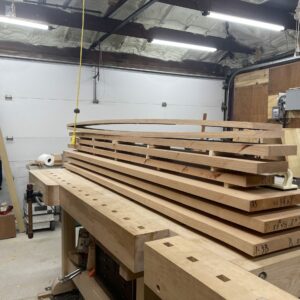Discussion Forum
Get It All!
UNLIMITED Membership is like taking a master class in woodworking for less than $10 a month.
Start Your Free TrialCategories
Discussion Forum
Digital Plans Library
Member exclusive! – Plans for everyone – from beginners to experts – right at your fingertips.
Highlights
-
Shape Your Skills
when you sign up for our emails
This site is protected by reCAPTCHA and the Google Privacy Policy and Terms of Service apply. -
 Shop Talk Live Podcast
Shop Talk Live Podcast -
 Our favorite articles and videos
Our favorite articles and videos -
E-Learning Courses from Fine Woodworking
-
-













Replies
Internal stress. Case hardening maybe. It happened to me enough that I just no longer resaw thick boards in this way. I buy thinner stock and plane it. And I always take equal amounts off both faces.
I don't have time to find it, but there was a nice little test that FWW posted a few weeks ago to help you figure out if your board is going to go bad.
In the meantime, I'd sticker those boards under some weight and see if they straighten out. They might be OK for some things. But I'd never trust them for something like door styles.
Thanks John. My goal was to bring them down to 1/4” and use them in a floating shelf, basically as the top and bottom of a torsion box.
You may still be able to use them, if you oppose the curves, convex to convex, they'll work to straighten each other. The way you plan to use them,at 1/4 inch, there shouldn't be enough force to fight the adhesive. I've been able to temporarily straighten such boards by laying them on the grass, in the sun, concave side down. Unfortunately, they will resume the curve soon after.
I've rarely had a problem of this sort. The reason is probably that I don't use wood from a sawmill or other purveyor of relatively freshly-made planks.
It's far less costly to go scavenging about for "waste" wood, which can not only include many fine old exotics as well as the more mundane timbers, but which is also extremely well seasoned. Much of it has been sitting about in an old & decrepit piece of furniture, or as first & second fitting parts in a house, for decades.
The sellers of timber, as with so many businesses these days, are intent on increasing the amount and pace of their turnover. To do so they cut corners when seasoning the wood. But good seasoning can't easily be accelerated.
Many of the older traditional makers of the C20th would buy then keep timber in their atmosphere-controlled (sort of) stores for years and years before using it. It makes a difference to how volatile that wood can be.
Lot of good tips here.
I have this problem a lot when resawing. it's really frustrating.
I didn't know of the things you guys have mentioned to try and mitigate it.
Red oak is a species that moves a lot in the first place. I wouldn’t use it for a project that needed resawn material.
In many cases this is due to the mill cutting from a “Curved log” where the tree grew with vertical curves in the trunk. It’s hard to find trees that have true straight growth, especially Red Oak. I have many Red Oaks on my property and they tend not to grow straight. Especially if they are on a sloped terrain. The white oaks seem to grow straighter but still have issues. On one of Peter Galbert’s video’s he discusses the issues with making making chairs using “green wood”and the importance of using straight logs as it does not have the internal stresses of curved growth wood. If you’re going to 1/4” thickness the stress in the wood shouldn’t matter. Getting it to 1/4” might be a bigger challenge.
Next time you’re resawing be sure to check the edge grain. It will give some idea of “tension”. I’ve seen the use of spacers and clamps on the outbound side to reduce surprises like you experienced.